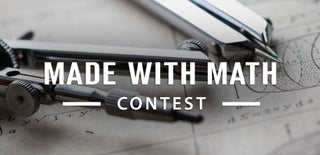Introduction: Constant Width Shape Cart
Shapes of constant width always fascinated me and I think they are pretty cool. You can use them for various projects like wheels for mini robots etc.
In this instructable I will show you how to draw various shapes of constant width which you can cut out of cardboard or 3D print them or make them on laser cutter.
Supplies
- piece of paper/cardboard
- pencil
- ruler (30cm)
- protractor
- compass
- M3 screws with nuts x 8
Optional supplies:
Software:
- Fusion 360 (or any other CAD software)
Optional hardware:
- 3D printer
- Laser cutter
Step 1: Drawing Shape of Constant Width
- Draw isosceles triangle (all 3 angles have 60 degrees)
- Draw a circle from one corner until it touches the other two corners (see picture above)
- Repeat step above for remaining two corners
- The intersection will be so called Reuleaux triangle which is a shape of constant width
Step 2: More Complex Shapes
- Draw a regular polygon with an odd number of sides. This is most easily done by drawing a circle, then making marks around the circumference equally spaced (by dividing 360° by the number of sides) for the corners.
- Use a compass to construct an arc from one corner to another, centered on the corner opposite.
- Repeat until you have used each corner as the center for an arc, and there is an arc from each corner to the next.
Step 3: 3D Printing
Using Fusion 360 which you can download for free as a hobbyist you can draw the shape of constant width and then extrude it to add thickness to it.
Then export your model as .STL file and you can then use slicing software like Cura to set up your file for 3D printer (see picture above)
For 3D printing I would recommend to use PLA and printing temperature 2015 Celsius, bed temperature 50 Celsius, layer resolution 0.2mm, printing speed 50-60 mm/s and infill 20%. As the slicing software I used free Cura which is available to download here.
Attachments
Step 4: Laser Cutting
In Fusion 360 you can save the 2D drawing as .DXF which can be used to set up file for laser cutting (see picture above).
For 40W CO2 lasers I would recommend to cut it in 3mm acrylic and for speed I would use 10mm/s and power about 90%.
For 60W CO2 lasers you can cut thicker acrylic (6mm - 9mm) and for speed I would use 10mm/s - 20mm/s (depending on thickness) and power about 70% - 90%.
Attachments
Step 5: Cart Assembly
In this step you will assemble 3D printed cart with constant width shape wheels :) You have two options, one is constant width cart assembled with just M3 screw or cart assembled with M3 screws and bearings which improve stability and reduce kinetic friction.
- 3D print 2 x frame_bearing file
- 3D print 8 x fork_bearing file
- 3D print 4 x wheel_bearing file
After printing you will have to glue together two pieces of frame and then insert bearings in the holes (24 bearing in total). Next step is to assembly all parts together using M3 screws and you can put a little bit of glue at the end of nut to make sure they will stay in place while your cart will move.
The video of the moving cart with wheels of constant width is available here.
You can use this constant width wheel base to make a cool robot based on Arduino or Raspberry Pi by adding motors, Bluetooth controllers etc.
For 3D printing I would recommend to use PLA and printing temperature 2015 Celsius, bed temperature 50 Celsius, layer resolution 0.2mm, printing speed 50-60 mm/s and infill 20%. As the slicing software I used free Cura which is available to download here.
https://www.youtube.com/watch?feature=share&v=RrxeBszGKnw&fbclid=IwAR1BciEi9QszV3DEw5miD8yfo_dWeCLfwiJj_7CW0ipmn8X1yeJlZo5YS6I&app=desktop

Participated in the
Made with Math Contest



















